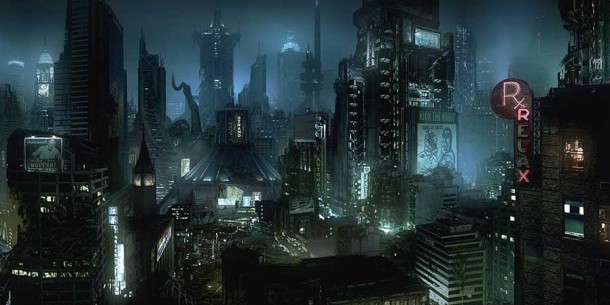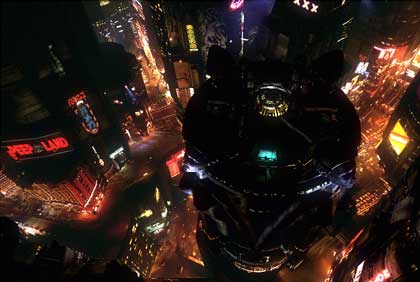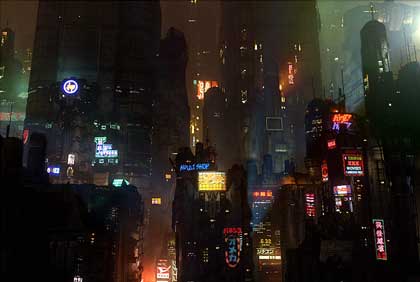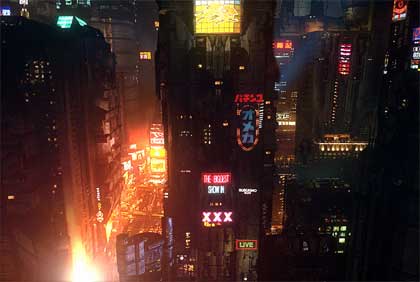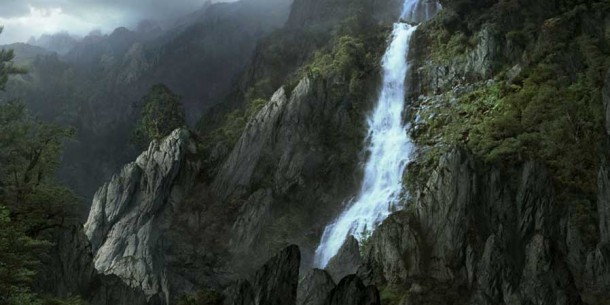Interview with Deak Ferrand
The creator of visionary landscapes- Deak Ferrand
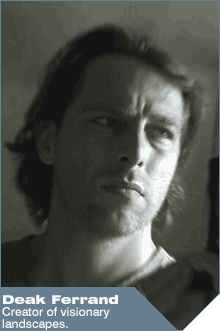 Deak Ferrand was fresh of school when we first worked together at Buzz in Montreal, nearly 10 years ago. His visionary talent blew me away back then. Just look at what he’s doing now on his web-site, and that’s just the tip of the iceberg! Deak’s work inspires a sense of awe. I believe it comes from a desire within him to inhabit the landscapes and worlds he creates. Deak’s clarity of vision and understanding of composition and light sets him apart from his peers. Combine this with a strong cinematic sensibility, and you’ll understand why the film industry wants to work with him. He’s also a really nice guy.
Deak Ferrand was fresh of school when we first worked together at Buzz in Montreal, nearly 10 years ago. His visionary talent blew me away back then. Just look at what he’s doing now on his web-site, and that’s just the tip of the iceberg! Deak’s work inspires a sense of awe. I believe it comes from a desire within him to inhabit the landscapes and worlds he creates. Deak’s clarity of vision and understanding of composition and light sets him apart from his peers. Combine this with a strong cinematic sensibility, and you’ll understand why the film industry wants to work with him. He’s also a really nice guy.
Meinert(MH): What was your cg experience before you moved to LA the first time?
Deak Ferrand(DF): I had done a lot of commercials and low budget movies. But having “Screamers” behind us made a big difference in being ready to work in LA. I really learned all my tricks watching Meinert and Gunnar. I remember the panic of those first weeks on the “Milky way” commercial. I was so afraid that I would be fired. I really felt inadequate.
MH: What finally allowed you to make the move to LA?
DF: I wanted to work for ILM at the time. But nobody was interested. Buzz decided to open a branch in LA to get some of the American production filtered through that office.
MH: I remember when I first met you your ambition was to work on big features. You got there pretty quickly. Has it met your expectations?
DF: I grew up with this “American dream” vision of working on Hollywood type movies.
By the time I started working on these movies, I realized that it did not make any difference in my involvement to do my best. I will give the same energy to a low budget movie as I would with a big production. I have no control over the quality of the movie, my work will never save a bad script or a lousy direction. That’s why I don’t read scripts before working on a project, I’m too afraid it will suck. I just want to work on projects that will challenge me in getting better at what I do, the rest is out of my control.
Vfx supervisor Eric Durst called us to create the futuristic city for the George Michael music video. Joseph Kahn is the director. Computer Café did all the compositing as well as the flying cars, animated neons and crowds.
MH: What would be your dream project?
DF: My dream project would be to work on an adaptation of “John Carter of Mars”.
MH: Do you remember how old you were when you started creating images? What did you create?
DF: I was very shy as a child, so I went into drawing my own world, I could draw for hours. I always liked giant landscape with tiny people lost in it. This theme has stayed with me since then. I can’t explain why.
Like a lot of us, I was introduced to super 8 when I was around ten years old.
The medium of film opened a panoply of crafts that I liked. From costume making to rubber mask, stop motion and miniature, concept art and storyboard, writing and music.
MH: What was your first computer experience? Can we get a sample of what you created with it?
DF: It sucks. I did this short animation when I was at the NAD center. At least it showed me that I’m a bad character animator.
MH: Which artists inspire you most?
DF: Right now, I am obsessed with Beksinski. Another artist that I go nuts over is Jeffrey Jones.
MH: Do you feel that what you do has a place in the fine arts?
DF: After reading about N.C. Wyeth’s struggle to be recognized as a fine artist, I got mad at those people thinking that commercial art is not at the level of fine art. I see no difference. I have more respect for somebody who will go through the task of infusing his work with his sensibility while dealing with the reality of constraints that is inherent in a collaborative environment. Does my work has a place in fine art ?. What do I care.
MH: What is your basic approach to creating a digital Matte painting?
DF: A good foundation. Composition is key. Everybody should own Edgar Payne’s book on composition for outdoor painting. Understanding light. After that, everything is allowed. Today, working in the digital world, you are free to use any tricks to get to the final product. Whatever works.
MH: How do you cut corners and could you give me a technical example?
DF: Here is something I use, it might sound stupid, but it works for me. I will spend days just thinking about the painting. Not sketching, nothing. If I start to work on the painting too early I loose my freshness. So I will let it simmer in my head until it has to come out. I will then work on it for two days, where eighty percent of the work is done. After that I will spend a week detailing the 20 percent left. Other than that, I would send the work early on to film. A lot of people spend too much time detailing their paintings when it is not needed. To see the painting on film before going crazy on details gives you a good idea on what to leave as is and where to concentrate your attention. You can really see that on old fashion matte paintings.
MH: Many of your matte paintings go beyond a static “beauty shot” – they often have moving cg elements. Do you feel that there are advantages to using cg models, and how do they compare to miniatures?
DF: I will use miniatures as much as I can. Nothing beats a miniature for light reference. On the other hand, cg models will speed up the process for perspective issues, mostly for architectural pieces. I’m starting to use radiosity on cg models when I can’t afford a miniature.
MH: With the advances in VFX what is the most difficult challenge these days?
DF: To stay informed on new software and hardware that will save you time.
MH: What was the most demanding project you worked on?
DF: I think Screamers is still the most challenging project I worked on, mainly because of being inexperienced at the time.
MH: What was the most fun project you worked on?
DF: Scorpion king
MH: Do you find time to work on your personal projects?
DF: Yes, that is one of the reason for opening my company. We are putting money and time back in the company developing in house projects.
MH: What are the issues matte painters have in dealing with film printing of their work?
DF: Unless your monitor is well calibrated, which is almost impossible, you will find that there is a big increase in contrast between the first negative print to the final positives that are sent to theaters. So you want to make sure that your master is not clipping too much.A bit flat is better. Also the problem in painting in 8bit linear space gives you a limited range compared to a cineon file.
MH: What are you currently working on?
DF: I’m in the middle of a movie called Helldorado, I’m also involved in Hellboy.
MH: Any upcoming projects you can talk about?
DF: I did some concept work for Van Helsing and will hopefully be involved in post.
MH: What advice would you give a give a beginner in the business?
DF: Learn to do everything by yourself, take initiatives, don’t wait for somebody to correct your work. People will give you one chance at showing your skills. Buy books and learn about the craft.There is a lot of good books on matte paintings. But the most important, you need to be able to criticize your work, and be tough on yourself.
Quick questions:
Age? 34
Place of birth? Switzerland
Were your parents involved in film or art? No
Favorite animated cartoon? Tex Avery
Favorite fairy tale? Tom Thumb
Favorite American film? The Man Who Would Be King
Favorite director? Ridley Scott
Favorite Foreign film? Seven Samurai
Favorite film to be made? I am Legend
Favorite book? The Martians Chronicles
Favorite traditional artist? Beksinski
Favorite materials to create with? Super Sculpey
What do you dislike the most about your work? Meetings
Who do you like to make fun of? Jean-Claude Van Damme
Interview by Meinert Hansen
Related Links:

